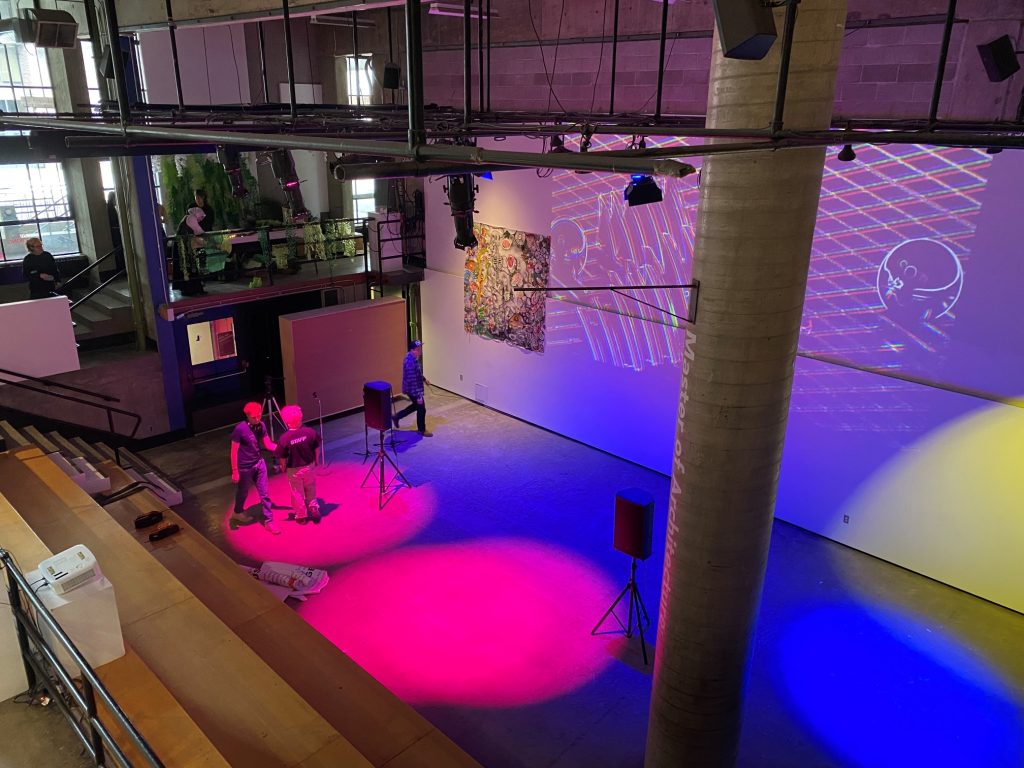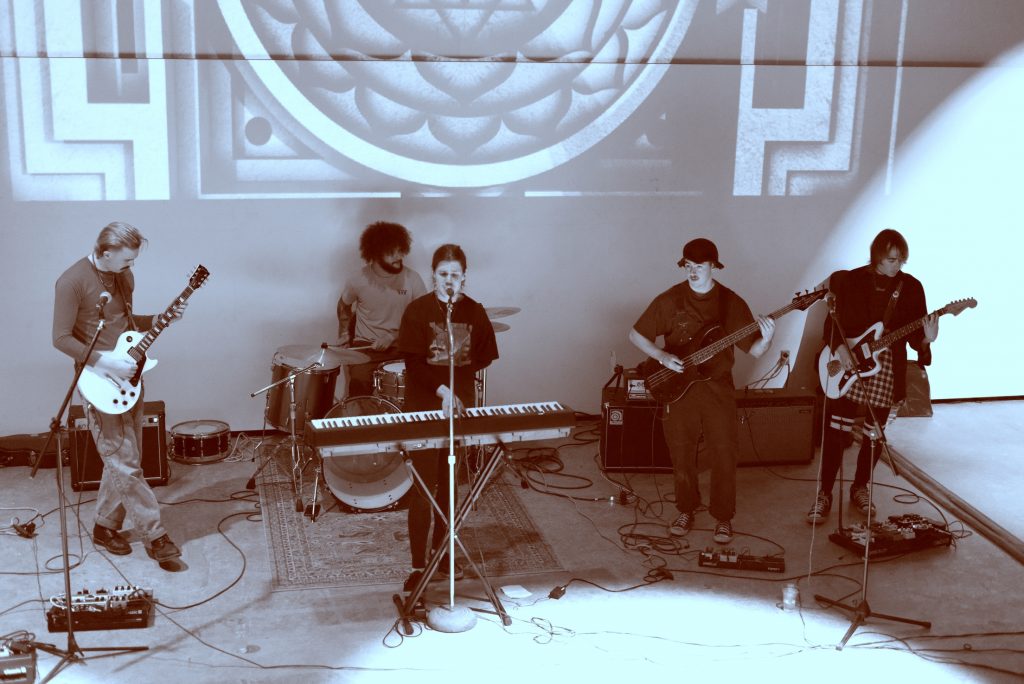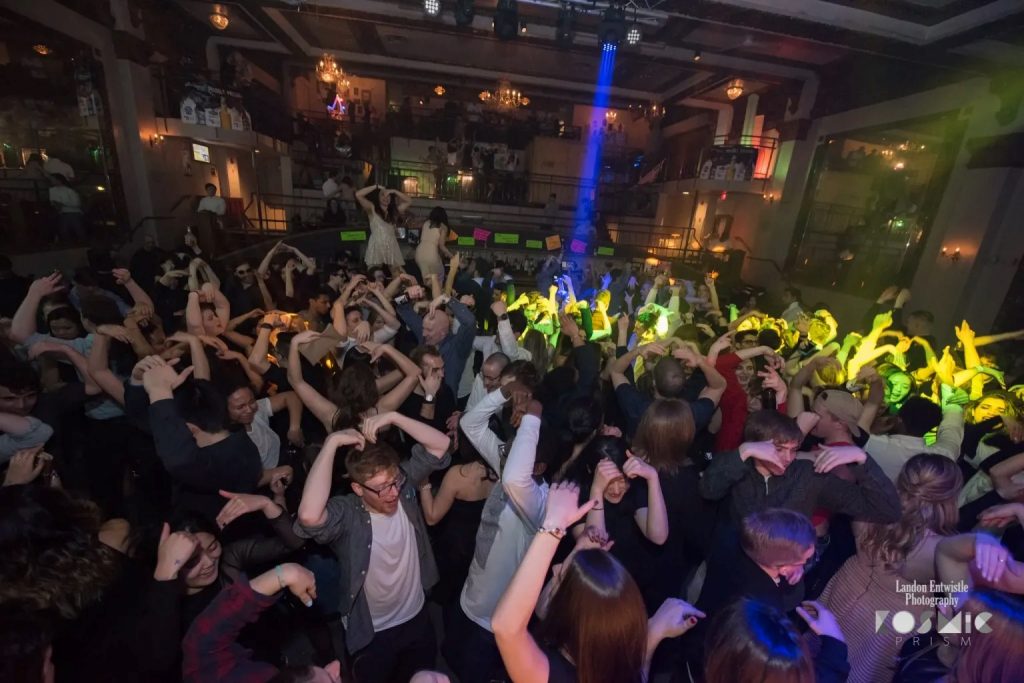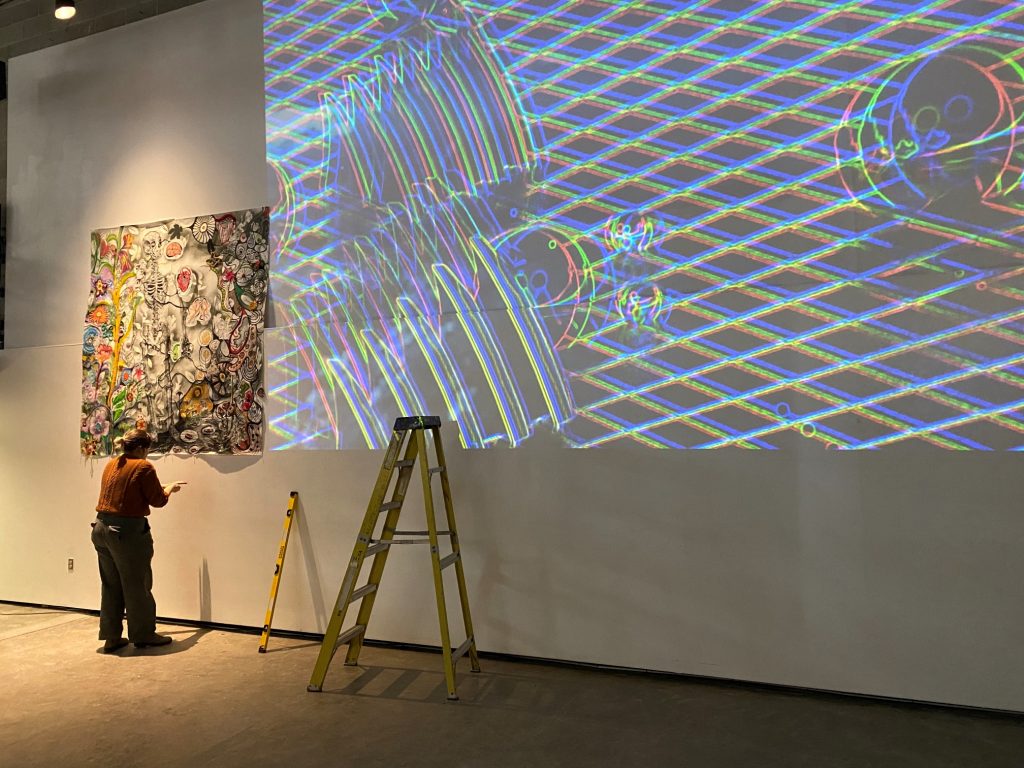The return of Kosmic to the Architecture Building
By Maria Cook
May 13, 2024
Kosmic, the legendary bash started by the school’s earliest students, returned to the Architecture Building in 2024 after an absence of nearly 20 years, thanks to the dogged efforts of a team of undergraduates.
On Friday, February 9, installations, music, and colourful lights greeted the 245 ticket holders, mostly architecture students, at what was billed as “an experimental party to celebrate design and architecture with exhibitions in our home aka the school.”

Students had mounted ephemeral and static exhibitions using projections, sounds, and materials such as paper, cloth, wood, and yarn, throughout the main floor. The Pit became a dance floor with live music and DJ sets, and the artist lineup included students Jasmine Bergeron, Noah Perkins, and Hasan Hirji, as well as alumnus Bennet Harvey.
The organizers, fourth-year students Cam Gordon, Connor Jermyn, and Noah Perkins, initially heard of Kosmic in 2019, when they were in the first year of the Bachelor of Architectural Studies program.
“The fact that at one point it was on David Letterman’s Top 10 parties in North America was something you heard often and felt like a testament to the wild energy of its earlier days,” they recall. “It was part of the heritage of the school, a capsule of the energy that we were becoming a part of when we first walked through those doors.”





For 17 years, Kosmic bounced around different venues in Ottawa, taking over the Aberdeen Pavilion at Lansdowne Park one year and Barrymore’s Music Hall another. Last year it was in the SAW Gallery. There was even an online version during the pandemic lockdown. These parties adapted to their locations, adding to the atmosphere with temporary interventions.

Nevertheless, the possibilities for environmental constructions and transforming spaces was limited in off-site venues, which in turn reduced opportunities for participation. Being able to transport, assemble, and disassemble sets rapidly became design criteria. In Building 22, students can fabricate in the shops and studios and set up directly. More people take part, building anticipation as well as the intriguing structures.
Inspired by stories of Kosmic’s past, Jermyn, Gordon, and Perkins, with support from other students, were determined to bring it back.
“In first year, you spend so much time in the building, living on campus and pumping out a project every week that the people and the studio become a new way of life,” they say. “The fact that Kosmic had happened in the school felt like the entire building was once unified in that way of life.
“Our passion for the event sprung from this idea that the walls of our space should be an active experiment, an ever-evolving statement on what was important and interesting in architecture,” they add. “Kosmic’s occupation of the school imagined that when students could manipulate the space, the ideas that floated around in our classroom could be built and experienced.”
Carleton University’s school of architecture was inaugurated in 1968. It moved from the Mackenzie Engineering Building to the new Architecture Building, designed by Carmen and Elin Corneil, during the 1972-73 academic year.
The first Kosmic took place in 1973 and was the brainchild of David Cavalier, who attended the school from 1971 to 1977. “It was a response to the winter blahs,” he told the Ottawa Citizen in 2003 on the 30th anniversary.
The name, he said, flowed from a class on Eastern mysticism. Some suggest it was inspired by Italo Calvino’s book Cosmicomics.
Music was a big part of it. Cavalier was part of a rock and roll band, the SoX, that got its start at Kosmic. The band included fellow students Chuck Wheeler, Janis Jones, and Frank Fentiman, as well people from outside the school.
Cavalier went on to have an architecture and graphic design practice in Perth and became the coordinator of Algonquin College’s architectural technology program. He died in 2014.
Memories are hazy, but Kosmic Kabaret seems to have been the original name. The format was part vaudeville, part talent show, recalls alumnus and retired professor Yvan Cazabon (BArch ’88).
“While there was live music, people also did comedy routines imitating professors, juggling, and general funny business à la Sgt. Pepper’s Lonely Hearts Club Band that inspired the era,” he says. “Students were very excited to use the Pit as a gathering and party space.”
In 1986, when Cazabon helped organize Kosmic, he invited the SoX back to play. The theme was Through the Looking Glass. A stage in The Pit was a large chess board, alluding to Alice in Wonderland, and a giant sculpture of Alice’s arm swung like a pendulum over the dance floor. Attached at the fourth-floor studio level where the fire doors are, it went diagonally from the upper street, over the lower street and the fingers pointed toward the stage.


Graduates who attended Kosmic in its heyday in the 1980s and ‘90s remember it as an extraordinary event, as much to do with the transformation of the building as the party. Preparation could take weeks. Crowds of architecture students and their friends, some dressed in costumes, danced, and unwound within the concrete walls of the school building which was filled with mind-bending audio-visual displays.
Kosmic was organized by third-year students as a fundraiser for Directed Studies Abroad, a full-term study trip. It took place during the fourth year of what was then a five-year professional Bachelor of Architecture program.
The students would alter the Architecture Building to reflect the theme, which changed every year, and has ranged from Kosmic Inferno to Kosmic Kanvas, which invited people to dress as their favourite painting. As a student in 1988, Stephen Fai, now a professor in the school, was director of Kosmic. The theme was Kosmic Apocalypse, and the centrepiece was a large collapsing cathedral. Other evocative titles over the years were Metropolis, Karavan, Kollapse, Eclipse, Ultraviolet, and Prism.
“Kosmic themes were meant to inspire the dress-up costuming that had become synonymous with the event,” says Cazabon.
One could freeze queuing in the parking lot (pre-Nicol Building) waiting to get in. Entering the party was often a special part of the evening. One year, people entered via the tunnel level and wandered through precarious and unstable walkways, dimly lit, and accented by strobe lights. “Very disorienting!” recalls Cazabon. Another year saw a yellow school bus parked at the main entrance. Attendees entered through its back door, checked coats, and showed their tickets before entering Building 22 from the front door of the bus.
Dream-like exhibits of structures, sound and light decorated the Pit, the Michael Coote Gallery, as well as rooms 204, 208, 209, the assembly room, and parts of the upper street on the fourth floor. In 1998, students constructed a mylar sphere that filled the entirety of room 204.
Over the years, Kosmic grew bigger through word of mouth. It hit a crescendo in the 1990s when it was mentioned on American television host’s Dave Letterman’s top 10 list of college parties.


Kosmic peaked in 2000 when tickets were oversold, and 3,300 revelers descended. There was pushing and shoving, and a fire alarm went off. Organizers were forced to provide refunds to nearly 2,000 non-attendees. The university banned the event.
In the aftermath, Cazabon, who was the faculty advisor for student events, and then-school Director Gulzar Haider pleaded for a second chance.
“I remember clearly the heated discussions on two occasions with VP-Academics, head of security, and other reps,” says Cazabon. “Their first response was a clear and absolute ban. Gulzar and I continued to make a case for the student event until they eventually set very limited conditions.” These included a maximum of 400 people and no bar.
Two more parties followed, including Freaky Kosmic, the 30th anniversary spectacle in 2003. As partygoers lined up outside beside broken-down trailers and carny games, they were able to peek in, unknowingly sticking their heads into cutouts of figures, such as the bearded lady.
Once inside, they travelled through a large white tunnel flickering with video images toward a strange world of three-dimensional fixtures, and 50 performers and artists, including “the world’s most tattooed man.” The Pit was covered with a tent-like roof, while a trick hallway and larger-than-life tables and chairs played with perspective. Girls on roller skates pushed popcorn carts and Dr. Mad Max, “bondage artist,” tied up guests in straitjackets.
“Cabaret, vaudeville, burlesque, freak shows we try to encapsulate it all,” Kosmic director Amber Salach, said at the time.
Another Kosmic followed in 2006 or 2007. Although it went smoothly, the students lost money without a liquor licence and fewer attendees. The event moved off-campus, becoming a rave-like party.
In the fall of 2023, Jermyn, Gordon, and Perkins broached the idea of re-introducing Kosmic on campus to Director Anne Bordeleau. She allowed them to pitch the proposal at the October 11 Faculty Board meeting, where they were given five minutes to talk.
With several faculty members expressing support for the idea, the trio was given the go-ahead to develop a proposal. The next several months involved many talks with Dr. Bordeleau and School Administrator Holly Klein-Swormink to determine what needed to be done to ensure a safe event. This included writing safety plans and applying for permission from the Carleton risk management team.
“The tenacity of our teammates was only successful because of the help, sometimes reluctant, of many people along the way,” says Perkins. “Everyone’s encouragement and interest galvanized us in the times when it felt impossible.”




At one point, the students waited outside of the office of Larry Kostiuk, dean of the Faculty of Engineering and Eesign. They needed his approval to hold an event in the Architecture Building after hours. They caught him on his way out to a meeting on the other side of campus. “We walked with him to his meeting, dodging groups of students in the tunnels as we explained what Kosmic was, how hard we had worked, and how we needed his help.”
Two weeks until the event, originally scheduled for February 2, the university’s risk management team abruptly withdrew permission. It was on the same day as Capital Hoops, and they felt their team was stretched thin.
“One of the biggest challenges was that those who had been there to see earlier iterations of Kosmic were thinking of everything that could go wrong,” says Bordeleau. “For better or worse, my heart was in it to trust the students, and the more stumbling blocks that were thrown their way, the more determined I was to do everything I could to support them.”
What followed was an intense lobbying effort on the part of Bordeleau and the Kosmic team to regain permission. The students did safety walkthroughs with campus security, rewrote their safety protocol, and mapped the exhibits. The concessions they made eliminated the ability to serve alcohol, limited the occupancy to 245 people, and pushed the event to February 9.
That afternoon, excitement was in the air, as groups of students installed, fastened, and hung their artworks. The theme was Cycles in Time: Decay and Rebirth. Most installations focused on recycling materials and followed an environmental theme with an emphasis on climate change. The suggested dress code was “‘organic.”


“It’s a perfect opportunity for this year to show this recycling of this event that we once had at our home, and seeing it regrow into something new,” Perkins told the Charlatan, which sent a reporter to the event.
Cazabon was happy to hear that Kosmic had returned to Building 22. “The design/build, multi-media, musical extravaganza belongs in a building that inspires design and improvisation.”
Bordeleau was among those in attendance. “Undeterred in their determination to brighten the gloomy winter months, the group successfully curated a wonderful evening of installations and musical performances, back in the Architecture Building,” she says. “I want to commend them for their care, proactiveness, and attention to all the limitations set out – a true inspiration for any designer that projects can thrive despite restrictive parameters.
As they graduate this spring, the organizers say they feel lucky for the opportunity “to hand down the culture that was handed down to us.”
See more images on the school’s ArkHIVE site.
Special thanks to Yvan Cazabon for contributing historical background to this story.